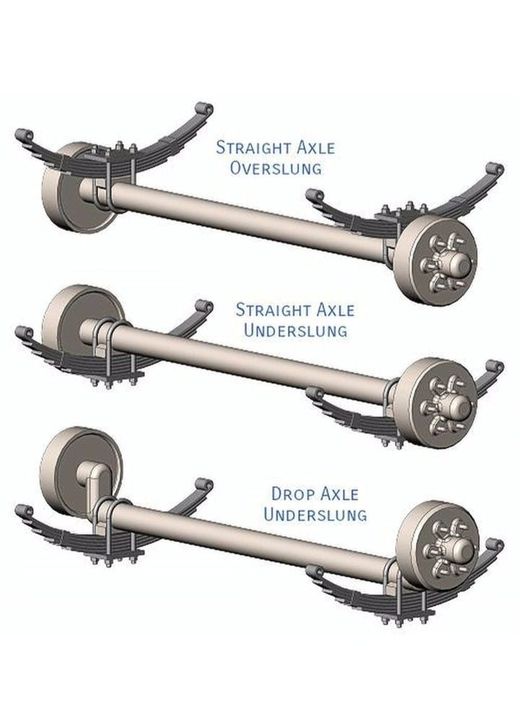There are three (3) different positioning types of mechanical springs suspension found on road trucks and trailers. Loadsense Truck and Trailer scale can weighing on trucks and trailers with Mechanical Spring suspension using our angle and height sensors.
-
Straight Axle Overslung

-
Straight Axle Underslung
-
Drop Axle Underslung
- Overslung vs. Underslung Truck and Trailer Mechanical Springs:
- Overslung Truck and Trailer Mechanical Springs:
- These springs sit on top of the axle, effectively being “over” the axle.
- The leaf springs are mounted above the axle beam.
- The trailer deck height is higher due to this configuration.
- Overslung springs are commonly used when you want to raise the trailer deck or increase clearance.
- Underslung Truck and Trailer Springs:
- These springs attach below the axle, effectively “hanging” from the axle using U-bolts.
- The leaf springs are mounted below the axle beam.
- Underslung springs result in a lower trailer deck height.
- They are often used when you need to lower the deck or accommodate oversize tires.
- The difference in deck height between overslung and underslung can be significant (e.g., 6.5 inches in some cases).
- Drop axles, which have the main axle beam lower relative to the wheel center, also use underslung springs.
- Advantages / Disadvantages:
- Truck and Trailer Frame Height:
- Overslung springs raise the deck height, while underslung springs lower it.
- Drop axles with underslung springs are great for lowering the deck.
- Raising the deck is useful for clearance or specific design requirements.
- Clearance:
- Higher deck clearance is often necessary for axle-to-frame clearance or larger tires.
- Some trailers are designed with the deck over the wheels, requiring additional height.
- Stability:
- Longer springs can contribute to stability, especially in multi-axle trailers.
- Ordering Considerations:
- When ordering axles and springs, specify whether you want overslung or underslung to avoid retrofitting issues.
- Different considerations apply to single-axle and multi-axle trailers.
- Truck and Trailer Frame Height:
- Overslung Truck and Trailer Mechanical Springs:
- Straight Axle Front Suspension:
- Beam Axle:
- Found in traditional cars from the 1920s to 1940s and in rear-wheel-drive trucks.
- Two types:
- Straight Axle Beam: No drop or gooseneck.
- Drop Axle: Designed to lower the deck height.
- Advantages:
- Simplicity and durability.
- Commonly used in vintage vehicles.
- Well-suited for heavy-duty applications.
- Disadvantages:
- Limited independent wheel movement.
- Rough ride on uneven surfaces.
- Less precise steering compared to independent suspension.
- Beam Axle:
In summary, overslung and underslung suspension affect the truck and trailer deck height and clearance, while straight axle front suspension provides simplicity and durability but sacrifices independent wheel movement and ride comfort


